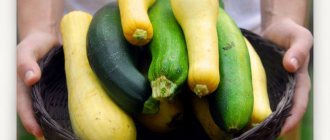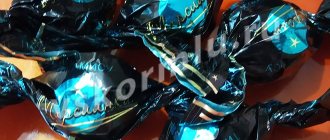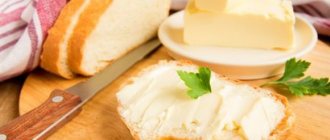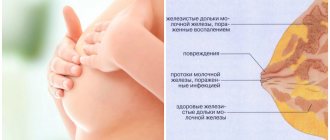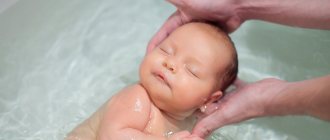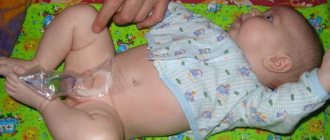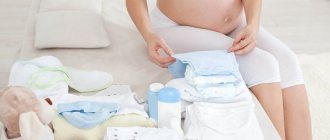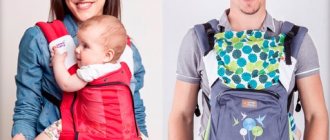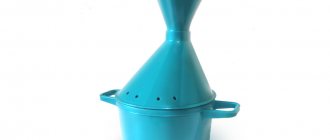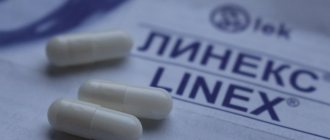February 13, 2019
Averyanova Sveta
By six months, the child no longer has enough mother’s milk; complementary feeding with fruits, vegetables, and meat is required. To make the process of getting to know new products interesting and simple, modern mothers use a nibbler.
This is a special mesh for babies that will teach them to chew without the danger of choking on a piece of food. We’ll tell you in more detail how to use a nibbler, when to start feeding through a mesh and which device is best to buy.
What is it and what is it for?
Nibbler is a children's gadget for self-feeding, an assistant for moms and dads. But this device has been known since ancient times. The great-grandmother of the nibbler was ordinary gauze or thin cloth; our ancestors wrapped crumbs, fruits, and meat in them and fed children. This is how the baby learned to chew, eat food on his own, and master new tastes.
The modern nibbler has an improved design. It consists of several parts: a mesh made of fabric or silicone, a holding mechanism for the nozzle, a handle, and a cap to protect against dirt.
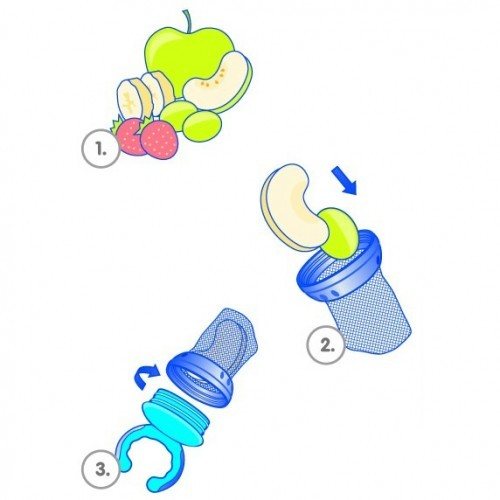
Cut fruits, boiled vegetables, bread and other goodies are placed in a food container (strainer). Screw the lid on and give it to the child's hand. The baby sucks the silicone nozzle, presses the gums onto pieces of food and squeezes out the juice from them. That is, he does not chew pieces, but drinks only the liquid that is secreted; he can swallow puree squeezed out of small holes in the mesh.
Some parents wonder why buy a nibbler if you can start feeding your baby purees, cookies mashed in milk with a spoon.
Of course, using a nibbler is not a mandatory stage of a baby’s development; it’s easy to do without it. But the use of such a device allows mothers to relieve their hands and teach their baby to be independent. Another important argument in favor of nibbler: the child receives not thermally processed puree as food, but fresh fruit.
On a note! Nibbler is also called fruittaker, chewer, fruit nipple, feeder. These are synonyms for the name of the same device for chewing food by babies through a strainer.
How to use the baby nibbler?
It's quite simple:
After purchase, at home, open the package and prepare the device:
• Each component must be washed using baby soap (special products or solutions should not be used for this) • Rinse all parts under running water to eliminate detergent residues • Then rinse the nibbler in boiled clean water The device is ready for use
Place the chopped vegetables or fruits in the mesh and secure it to the handle using a fixing ring.
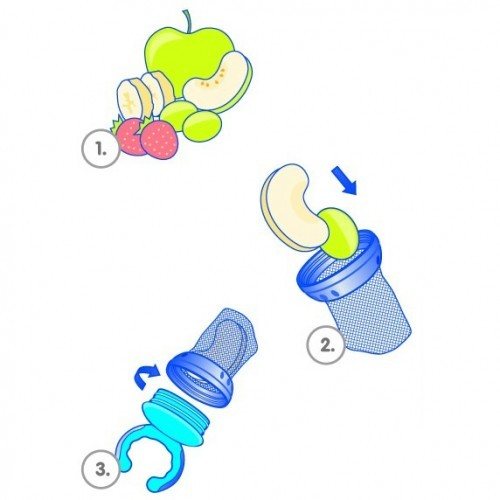
• After this, the nibbler can be given to the baby and he, holding the device in his hands, will be able to chew on the offered product.
After everything is eaten and the bag is empty, the parents take the nibbler and wash it.
• Disassemble the device • Process all parts (as described above) • Dry and store in the same way as baby bottles or nipples
It should be noted that nibbler is not entertainment, but a feeding process and you should not leave the child unattended. Juice released from the product or your own saliva can cause your baby to choke. Do not allow your child to use it as a toy or entertainment, otherwise the child will use it for these purposes.
From what age can it be used?
A fruittaker can appear in the house for active use when the baby is 5–8 months old. It turns out to be a long time run-up. But the fact is that the need to accustom a baby to a nibbler depends on the following factors:
- What type of feeding is the baby on? If he is artificial, then complementary foods are introduced earlier, at 4–5 months. The purchase and first experiences of using a fruit net should be dated to this period. If a small child is breastfed, then the introduction of complementary foods is postponed for a period of 6–7 months, which means that the nibbler will come in handy a little later than with artificial ones.
- Is the baby cutting teeth? Use a fruit taker to help with baby teeth eruption. This process can begin either at 4 or 8 months.
- Are fruits and vegetables allowed for the child? Allergic children receive complementary foods from sweet, juicy plants and meat no earlier than 6–7 months, when the immune system is stronger. The need to use a nibbler is delayed until this age.
Another important factor that mothers should take into account when deciding to give their baby complementary foods through the mesh is the opinion of the doctor. If your doctor allows the introduction of new products, feel free to buy a fruittaker and use it without fear.
Opinions for and against

The usefulness of nibbler for a baby is determined by each parent independently based on personal experience or stories from friends. Here are the most common arguments for and against feeding nets, voiced by opponents and supporters of the device.
pros
Proponents of using fruittaker talk about the following positive aspects of a modern children's gadget:
- The baby will not choke on pieces of food. The mesh does not let fibers or crumbs through, only juice gets into the child’s mouth. It is safe for a toothless baby.
- Nibbler helps teeth erupt, scratches gums and relieves itching in the areas of future incisors. If you put chilled fruits in the net, the process of chewing them turns into real relaxation for the baby.
- You can give it to your child on the street, while traveling in the car. The baby sits in the stroller and eats, is busy with work, and is not capricious.
- Using a feeding net you can expand your baby's diet. Any fruits and vegetables that are so difficult to give in pieces are placed in it. For example, fibrous orange, hard pineapple.
- The bright design attracts babies, the nibbler becomes a favorite toy.
- Low price. You can buy a good footer at a pharmacy for 250–600 rubles.
Minuses
Among the disadvantages of using a nibbler are the following:
- A silicone or fabric mesh quickly deteriorates, losing its aesthetic appearance from the juice released by fruits and vegetables.
After several uses, the bag becomes dark in color and is difficult to wash. You need to buy replacement nets at least 2-4 times a month. But this only applies to the fabric version of the nozzle. - Vegetable and fruit juice flows out of the container when pressed with gums and lips. As a result, while eating, children get dirty and their clothes become dirty. And if you use the Nibbler while walking in a stroller, the seat and armrests become dirty.
- The device is heavy for a 4-6 month old baby. If you put fruit inside and give it to the baby, the baby will have difficulty holding it on his own. The mother has to help the baby, so we are not talking about independent feeding.
Features of using the nibbler
Usually, babies begin to give pieces of fruits, vegetables, and cookies from six months. A little earlier, you can put pieces of bread into the nibbler - the baby is probably already familiar with this product, but the crumbs will not pass through the small holes of the mesh container, and the baby will not choke.
To begin with, try giving your child those fruits and vegetables that he has already received in the form of puree - an apple, banana, carrot, orange, etc. During a difficult teething period for the baby, try putting chilled or frozen berries in the nibbler - they will help to naturally relieve pain, swelling, discomfort.
From what age can it be used?
At 4-6 months, introduce your baby to the nibbler. By this time, the child has formed a chewing reflex, and any drying material in his hands is immediately sent to his mouth. So he not only scratches his gums, but also tries to chew. By 6 months, the child’s body is ready to accept other foods, and he himself begins to show interest in it. Previously, mothers or grandmothers would lightly tap the baby’s tooth with a silver spoon and, if the sound was loud, they would begin to give solid food. Now is the time to offer him a nibbler with chopped apple pieces, and then other fruits and vegetables.
How to use
This device is easy to use. After you have purchased the device and brought it home:
- open the packaging blister and disassemble it into separate parts;
- Wash each part with detergent for baby bottles and dishes. Below is a list of products that, according to reviews from mothers, have proven themselves;
- Additionally, rinse all parts with clean boiled water. Scald the silicone mesh with boiling water;
- cut vegetables or fruits into pieces, place in a net;
- secure the container securely to the handle using the ring.
Now offer the Nibbler pacifier to your baby. The baby is attracted by its bright design, and he will happily chew a piece of fruit, gradually turning it into puree and absorbing it through the holes. After the contents of the mesh are finished, take the fruittaker.
Wash the device by disassembling it completely. Process each piece as mentioned above. Dry everything and store it with other children's dishes.
| Name of detergent for nibbler | Properties | Price |
| Gel “Children’s” (Nevskaya Cosmetics) | Does not smell, does not contain dyes or phosphates | 50-70r per package (500 ml) |
| Aqa Baby Gel | Economical, has a pump dispenser, washes off well, lasts for 3 months, safe for babies from the first days of life. | 130 RUR per bottle (500 ml) |
| Pigeon dishwashing liquid | It has an antibacterial effect; there are no phosphates or chemical dyes among the ingredients. The product is economical: 2.5 ml of gel is used per liter of water. Japanese manufacturer. | 450-500 rubles per package (700ml) |
Safety regulations
Any mother considers her main task to be creating a safe environment for her child. What is a nibbler and how safe is it?
The device is simple. It includes:
- a handle-holder convenient for a child’s palm;
- a replaceable mesh where pieces of fruit are placed;
- tight-fitting fixation ring;
- lid-cap (placed on the mesh, tightly adjacent to the handle).
Instead of a mesh, the fruit taker has a silicone tip with many holes. Nibbler has a valuable advantage - it makes life a lot easier for parents. The child eats the offered foods finely chopped, and the mother does not have to worry about the safety of consuming complementary foods.
But, despite the secure fixation of the device, there is always a risk that the child will unscrew the mesh on his own (if he is older) or chew the silicone model.
No matter how busy your child is with the nibbler, never leave him alone with his toy. Splashed juice or saliva can enter the baby's respiratory tract, causing him to choke.
When choosing a feeder, pay attention to its brand and country of manufacture. Make sure there is a certificate, ask if the packaging has a mark on derma testing and whether it is indicated for use by children, be sure to study the composition of the material. Well-known companies use nylon, silicone and special food-grade plastic that is safe for children (polypropylene) to create nibblers. It is durable and will not crack if dropped or hit.
Which one is better to choose?
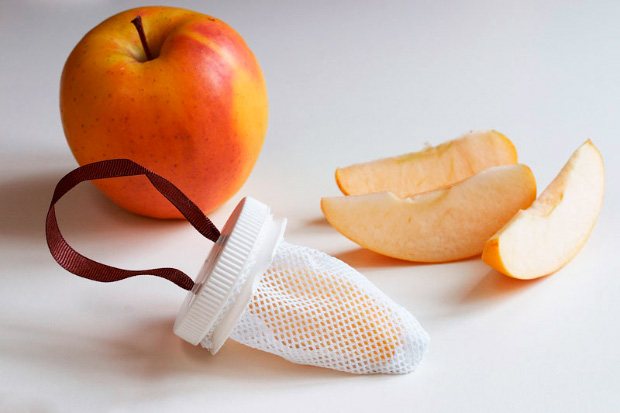
To buy a high-quality accessory for feeding your baby, we recommend paying attention to the following characteristics of nibblers:
Firm
Trust trusted and world-renowned manufacturers. Perhaps the device will cost more than more economical analogues from unknown companies, but it will last longer and will not harm the baby’s health. We recommend buying nibblers from Nuby, Canpol Babies, MamaSense, and domestic companies. Never consider purchasing Chinese options, for example through Aliexpress.
Material
Be sure to see the composition of the material in the instructions for the device. If the instructions indicate that the product has been tested by dermatologists, recommended by pediatricians and meets quality standards, feel free to buy it. Strong-smelling, cheap plastic and silicone can be identified without special skills.
Inspect the nibbler, smell it, click on the mesh. If what you see does not inspire confidence, refuse to purchase.
Mesh
There are two options: silicone and textile. Choose according to your child’s financial capabilities and preferences. Please note that there is a replaceable mesh, the possibility of replacement after prolonged use.
Comfortable handle
The baby will use the nibbler independently, so the handle of the device should be ergonomic for a child’s palm. The important information here is from how many months the baby will eat through the mesh. If from 5–6 months, choose an oblong-shaped handle, in the form of a ring; for older babies, choose a round one.
Nibbler weight
Ask the seller how much the gadget weighs. It will be difficult for a child to support a container with food weighing more than 200 grams. The lighter the nibbler, the more attractive it is to you.
Availability of additional parts
These are caps to protect the mesh from dirt and dust, a mechanism for pushing food debris forward and replaceable nozzles. The more functionality, the more convenient the nibbler.
On a note! Which nibbler to choose and how to use it correctly, says Dr. Evgeniy Komarovsky in his TV show.
At what age, at how many months, should Nibbler be used?
Be sure to pay attention to the recommendations for use, ask for help from a consultant and ask to show you the mesh size. If it is not large and has an oblong shape (it does not matter if it is a nylon or silicone nibbler), then it is intended for young children up to 8, maximum 12 months.
For children older than one year, the holes in the mesh are larger and the mesh itself has a larger size and larger holes.
All this should be indicated in the recommendations on the packaging, however, it is worth asking your consultant once again. Be extremely careful in your choice. You should not buy products from companies or Chinese manufacturers you are not familiar with, pay attention to the quality and price of the product. The health of your baby depends on this.
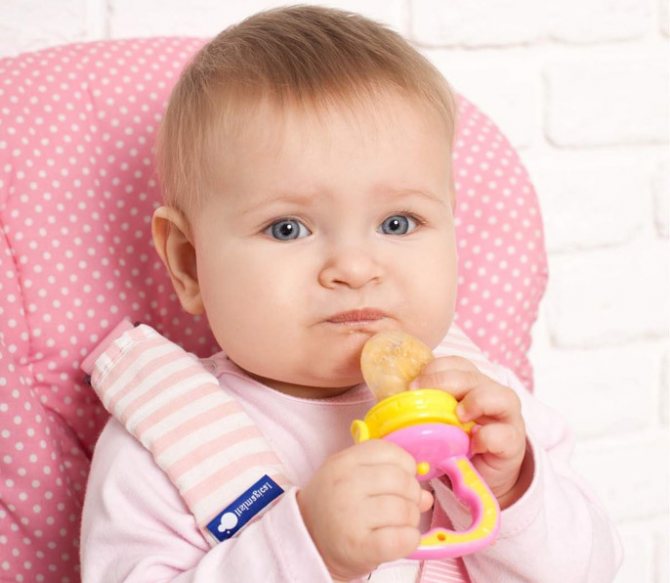
Which material is better
Pharmacies sell different types of nibblers based on color, size, and manufacturer. There are also two types of attachments: silicone and cloth (nylon mesh). It is impossible to say unequivocally which one is better. Each has its own pros and cons. Let’s compare both materials to make it easier for you to choose a fruit taker model based on this characteristic.
| Silicone product nozzle | Grocery cloth attachment |
| Soft or dense depending on the type of material for production | Soft at the initial stage of use, after which it can be slightly harder than silicone |
| Safe, if high-quality material is used, buy a branded nibbler at a pharmacy or a well-known retail chain | Safe for children. Natural textiles or nylon are used for production |
| Recommended for children during the teething period (from about six months): the mesh helps relieve itching, pain, and is used as a chewer for swollen gums. If your baby has teeth, there is a risk of biting off the material during use. | You can buy it for a child at any age and with any number of teeth; it is difficult to bite off the textile base with baby incisors |
| Does not change color when used | May darken from fruit acids |
| Easy to care for | It is difficult to wash away food residues, especially fruits and berries. |
| Replacement nozzles are rarely included with the nibbler; it is almost impossible to find replacements separately. If the silicone tip gets holed, you'll have to buy a new device. | The kit often includes replaceable mesh blocks; it is possible to buy replacement parts separately |
| Average life of the nozzle: 2–3 months | If used frequently, you will have to change the mesh at least once a month. |
| The cost of chewing gum with a silicone nozzle ranges from 250 to 500 rubles per piece | A nibbler with a nylon nozzle costs an average of 180–250 rubles |
From what months can Nibbler be used?
From birth to 5-6 months, the oral cavity of children has a unique ability - a thick tongue and dense cheeks allow only liquid food to pass through well. If a child aged 2-4 months is given even a small piece of solid food, he will spit it out. The baby still doesn’t know how to chew (and there’s nothing to chew with), the hard edges of the food irritate the delicate mucous membrane, and the tongue blocks the natural passage.
If foods intended for feeding are crushed, the baby may try to swallow the mixture, but there is a high risk of choking. That is why the child needs to be prepared for a new serious manipulation using a feeder.
Many new parents believe that the child can chew if he has teeth, and he does not need any nibbler. In fact, the front teeth are designed for biting food, and they will not help much in chewing.
The optimal time to start using the feeder is the moment of introducing complementary foods. This is often 6 months for breastfed newborns and 4 months for those accustomed to formula milk.
The timing may change depending on the individual characteristics of the baby. Some children at first refuse the offered “toy” simply because they do not like the new taste. In this case, you need to take a break or choose another product. It is important to remember that you cannot force a child, otherwise, given the negative experience, he will not use the feeder at all.
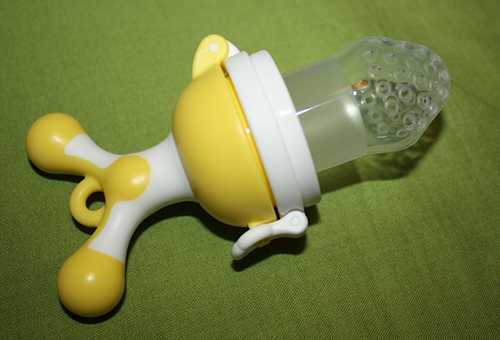
Nibbler with silicone mesh
How to use it correctly
Feeding through a feeder should be carried out according to the following scheme:
- Immediately after purchase, the new nibbler should be thoroughly washed with hot water and soap or baby dishwashing detergent, then boiled for several minutes.
- It is recommended to feed breastfeeding children and infants with fruits and vegetables after the main meal or as a snack between breakfast and lunch.
- The Nibbler should be rinsed with boiled water before each use.
- Cut the products into small pieces; hard apples can be grated.
- Place the complementary food in the mesh, screw on the lid, and check the tightness of the mechanism.
- If you want to give fruit to your child chilled, to relieve gum pain during teething, place the filled fruit taker in the refrigerator for a couple of minutes.
- Give a 6-7 month old baby the device in his or her hands; 4-5 month olds will have to help hold it for the first few days.
- After your baby has completely sucked the juice out of the food, remove any excess from the bag and rinse all parts of the feeder with hot water. Disassemble the device into its component parts: mesh, piston, cover.
- Use a soft brush to remove remaining fibers and fruit juice from the mesh.
- After washing, dry the nibbler and put it in the closet.
Important! The Fruit Taker cannot be washed in the dishwasher using aggressive detergents. Powders remain on the surface of the device and become clogged in the mesh cells. They can enter the child’s esophagus when sucking food and cause poisoning.
To clean the nibbler, use baby products or only hot water.
How to use a nibbler: safety rules
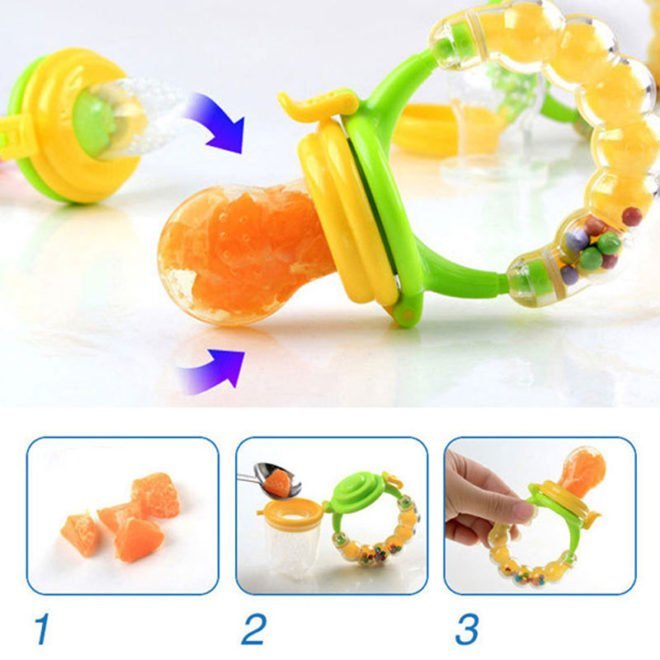
The main condition for use is ensuring safety. It’s easy to understand how to serve fruit in a nibbler with a mesh or silicone nozzle. For successful application you only need to follow certain rules:
- After each use, thoroughly rinse the product in hot water, preferably with boiling water to remove germs and microorganisms.
- In the first stages of use, it is advisable to use soft fruits and vegetables, such as nectarine, peach or banana.
- It is not recommended to place cookies in the container: their crumbs can get into the baby’s windpipe.
- The device is not recommended for storing ready-made purees.
- Despite the rigid fixation of the lid, careful monitoring of the baby is required when using this type of nipple.
- You should not let your baby chew on an empty device: it is better to take it away and wash it thoroughly.
After the first days of using the product, most parents note how successfully they managed to introduce various healthy foods into their baby’s diet.
What can you put
When choosing products to fill the mesh, be guided by the child’s age, the presence of teeth, the baby’s taste preferences, and recommendations for the introduction of complementary foods for children. If the baby is 5–6 months old and is not allergic to fruits and vegetables, put in the nibbler:
- Any berries, fruits, but without seeds. These are bananas, kiwi, peaches, apples, pears, apricots. Citrus fruits are given after 7 months, if diathesis or allergies do not appear.
- Boiled vegetables. Carrots, cabbage, beets, pumpkin, zucchini, broccoli.
- Cookies, crackers. Not the most popular option for mesh products, but if you choose cookies that quickly dissolve from saliva, your baby will definitely like it.
- Small pieces of cooked meat. These are beef tenderloin, chicken breast, diet rabbit and turkey.
See how to properly put fruit in a nibbler.
At first, the list of products for nibbler will be small - carrots, broccoli, unsweetened pears and green apples. As the baby grows, by 6–7 months, you can already put meat, cookies, and a wider range of fruits and vegetables in it. Add new ingredients to the menu gradually so as not to provoke an allergy in the baby.
Features of the nibbler
If you place chilled berries, fruits or vegetables in the nibbler, this will facilitate the appearance of the first teeth, and the mesh will massage the gums.
All feeders are made from special materials that cannot harm children's health. When the first teeth appear, it is necessary to monitor the integrity of the mesh used. At the first sign of wear, it should be replaced.
Particular attention is paid to hygiene; after use, any remaining food should be removed and the nibbler should be disinfected.
Modern mothers have a lot of convenient devices in their arsenal that make life easier and ensure a joyful childhood for their baby.
Safety regulations
Fruittaker itself is safe for infants. The fruit teat is screwed on tightly, the rotating strainer mechanism is tight - the baby is unlikely to be able to open it on his own.
It is also impossible to choke on pieces of food if the mesh has no damage or holes.
But despite all the safety benefits of the device, parents are not recommended to leave their baby alone with the feeder to avoid accidents. The instructions for the nibbler contain a list of several more safety rules:
- Replace the mesh with a new one if you see the slightest cracks or wear on the surface.
- Do not give your baby a fruit pacifier that is not full. If the baby has even one tooth, he will tear the sac.
- Check the device for integrity and cleanliness before each use.
- Do not teach your child to open the mechanism on his own.
Rating of the best
Nibblers for infants are popular products, which is why the range of such products in pharmacies and baby goods stores is very wide. Let's present a list of the best models that have received positive reviews from customers.
Nuby
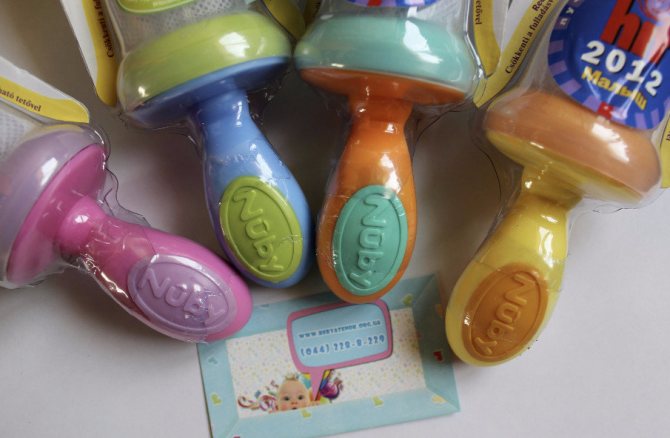
It was this brand that gave the name to the fruit taker in Russia. The company presents a large selection of chewing gums with silicone and textile attachments. The nibbler is equipped with a handle with a rubberized part; it is comfortable and easy for children to hold it independently. The kit includes a protective cap for the mesh, so it’s safe to take the nibbler with you on the road or outside.
Happy Baby
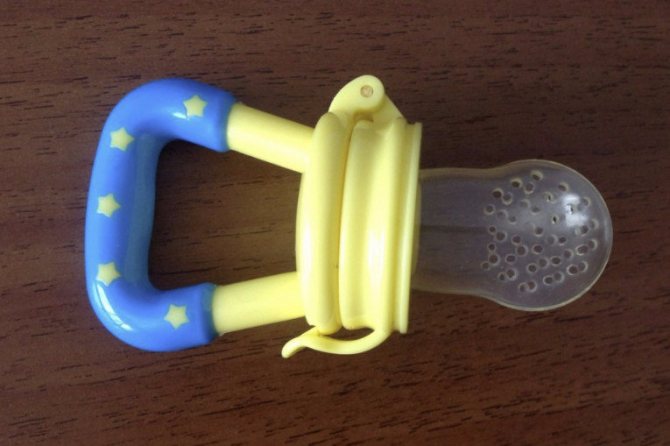
Nibblers from this company are made from high-quality silicone and polypropylene that is safe for babies. The device is equipped with a comfortable handle for holding with small hands. The main advantage of Happy Baby nibblers is the mechanism for pushing leftover food forward.
"The world of childhood"
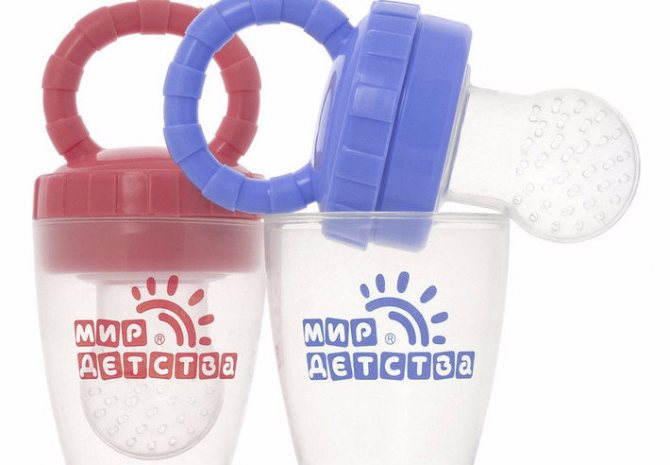
An inexpensive option for a feeding net. The average price is 130 rubles. Made from quality material. The mesh is made of textile, the cells are small, so the child will not choke on pieces of fruit or bread. Replacement nozzles can be purchased separately; additional meshes are not included in the kit. Allowed for children from 6 months.
MamaSense
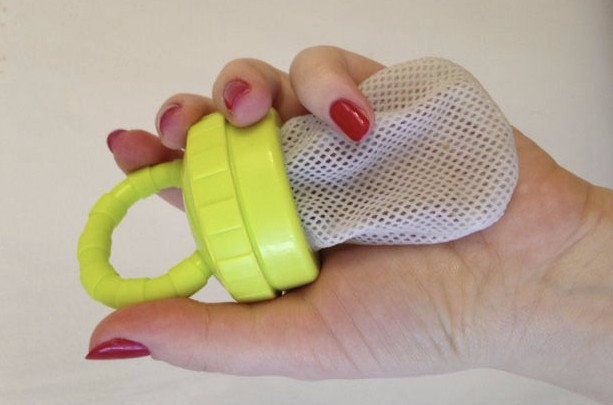
The silicone chewing attachment, according to customer reviews, is very durable, so it can be used for a long time even by children with teeth. If the mesh wears out, you can purchase a replacement one. The bright design of this company’s nibbler attracts the attention of children; they enjoy looking at the accessory, playing and eating with it on their own.
Nibbler nipple
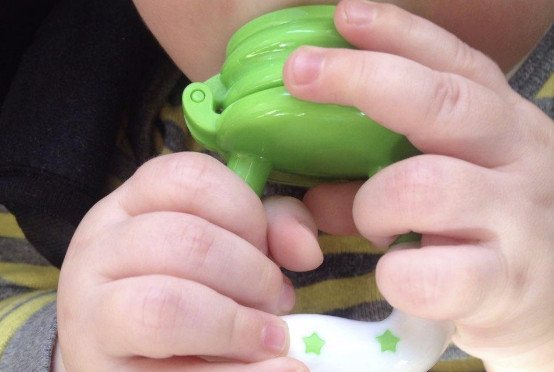
Another interesting option for a device for feeding a child with goodies. It looks like a large pacifier with a food container inside. You can put a small amount of fruits, berries, porridge, cookies and other food there. The baby sucks it and gets gastronomic pleasure. You can teach your child how to use this device in a couple of minutes.
Which nimbler to choose?
The first analogues of such a device for feeding a baby have existed since ancient times. Our great-grandmothers put crushed or chewed food in a piece of gauze, bandage or fabric and tied it in a knot - this was called “chewing.”
Modern manufacturers have left the essence of the invention unchanged, but the form itself of this method of complementary feeding has been significantly improved.
Different nibblers differ not only in the shape of the handle, but also in the type of fabric from which the strainer is made. It is very convenient for a child to hold nibbler models with a classic handle - with a non-slip rubberized surface.
The ring handle, in addition to developing the grasping reflex, is very convenient for attaching to the back of a crib, the handle of a child chair, stroller, etc. Many models are sold with a protective cap that closes the mesh container.

